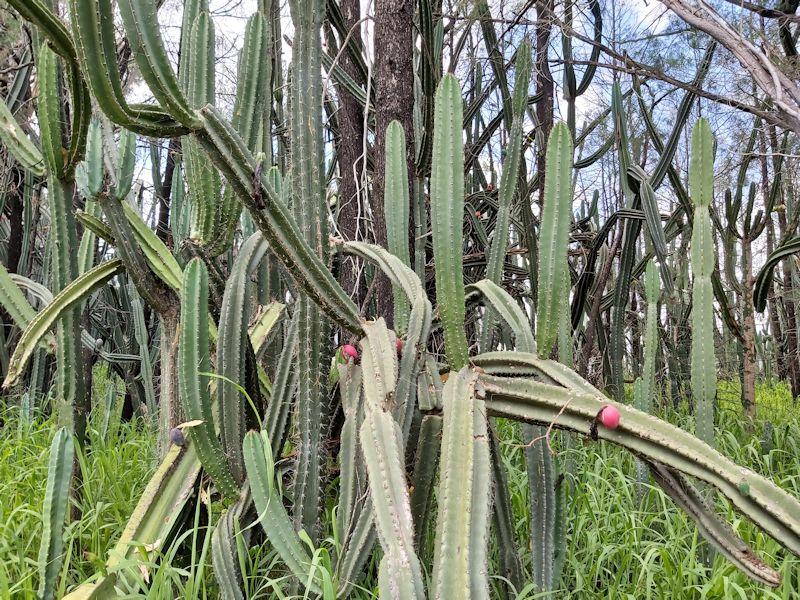Willows Cactus

Cereus Cactus, also known as Willows Cactus or Queen of the Night Cactus, has a tree-like growth habit with a distinct trunk after which, it branches freely up to 10 m high. Its stems are up to 15 cm across, have 4–6 ribs. They are spiny and are divided into segments. They are blue-green in colour when young, becoming duller green with age. The white flowers are very large, up to 25–30 cm long. The flowers are followed by fruits, which are red when ripe and full of seeds.
General
- Willows cactus is a common ornamental plant in Queensland gardens because of its interesting shape, large white flowers and edible fruits.
- Willows cactus can form dense infestations that compete with native vegetation, limiting growth of small shrubs and groundcover species. Willows cactus can also reduce pastures and land availability for grazing animals.
Description
- Willows cactus is a perennial succulent tree that can grow up to 8 m high with multiple vertical stems and branches.
- The stems are succulent, green and spiny, and they are covered with a bluish, waxy layer. The branches and stem usually have six conspicuous lateral ribs on which arrangements of 6–8 spines protrude. These spines are approximately 10–20 mm long.
- The white flowers are approximately 150 mm long and are funnel shaped. These flowers occur along on the stems of the plant. The flowers mostly open at night and close again in early morning.
- Willows cactus produces large red fruit that contain hundreds of seeds. The fruit are very attractive to birds and spread easily.
Methods of Spread
- Spread by birds and animals that eat the ripe fruit and disperse the seeds in their droppings
- Stem fragments can also be a source of spread if garden plants are incorrectly dumped or floods move segments to new locations
Life cycle
-
Willows cactus reproduces mostly by seed.
-
It can also reproduce vegetatively given the right conditions. The flowers are pollinated by bees and night flying insects. Pollinated flowers produce a large apple sized red fruit that contain white flesh and hundreds of black seeds about the size of a pin head.
Control
- Best control for willows cactus incorporates integrated management strategies, including herbicides, mechanical, physical and biological methods.
-
Physical
- Dig out plants completely and burn or deep bury. Ensure that all tubers that can grow are removed and destroyed.
-
Mechanical and Fire Control
- Mechanical control using machinery can quickly reduce the size of the infestation. Although willows cactus can regrow from stem segments, this is a slow process and so opportunity exists to push up the cactus and burn at a later stage. More research is needed to ascertain the effectiveness of fire on seedling and young plants in pasture situations. Before burning, consult Biosecurity Queensland to see if this practice is suitable for your pasture and land management practices.
-
Biological Control
- An introduced mealy bug (Hypogeococcus festerianus) insect has become established in Queensland. The insect is now present in willows cactus infestations near Cecil Plains, Miles and Tara in southern inland Queensland.
-
Herbicide Control
- Treatment with herbicides can be effective, because the plants are relatively easy to find.
- There are no herbicide products specifically registered for the control of willows cactus in Queensland. However, a permit held by the Department of Agriculture and Fisheries allows people generally to use some herbicide products to control willows cactus as an environmental weed in various situations. Treatment options and permit conditions can be found in the Queensland Government fact sheet (Table 1)
Resources
Willows Cactus Fact Sheet (printable pdf)
GRC Biosecurity Plan 2019/2022
GRC Biosecurity Plan 2019/2022 - Community Objectives (pg19)
Biosecurity Queensland Website
Department of Agriculture and Fisheries Website















